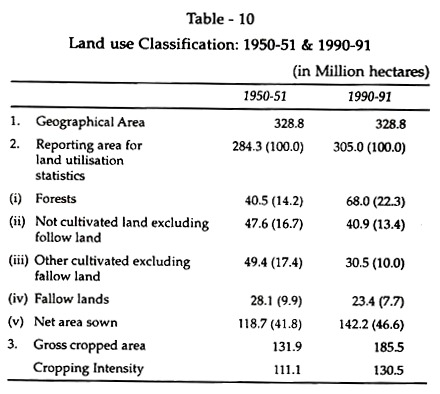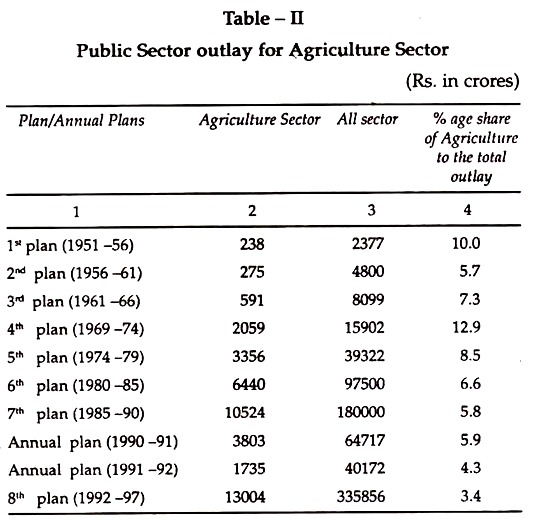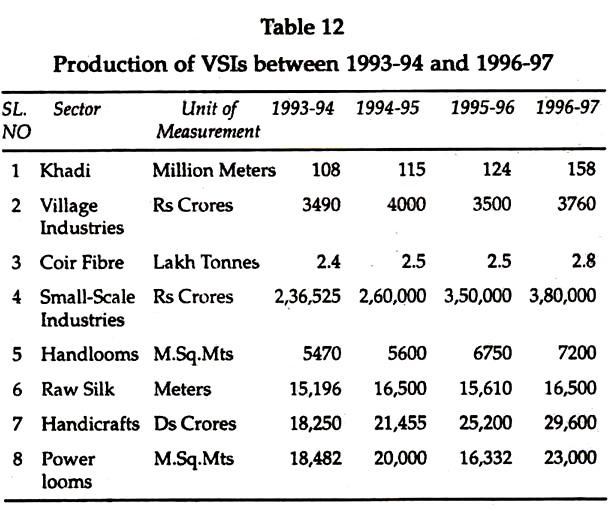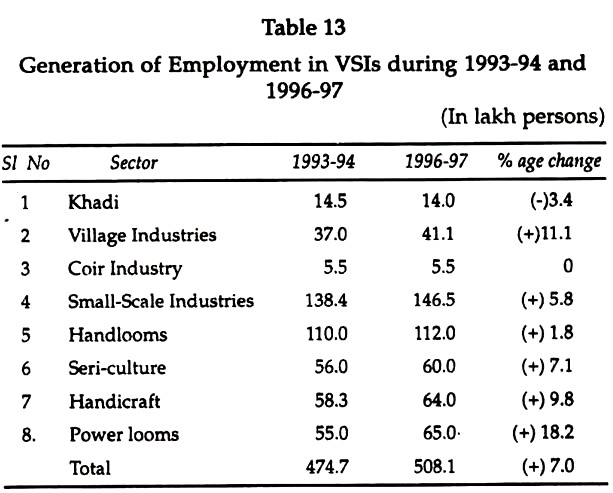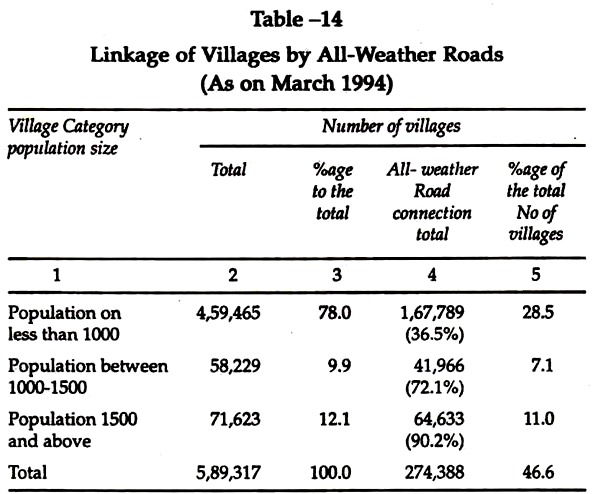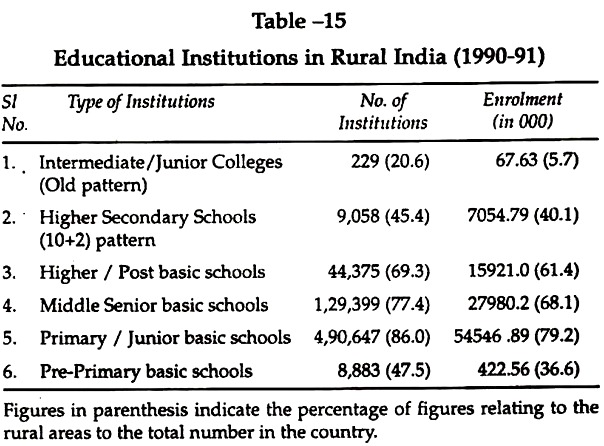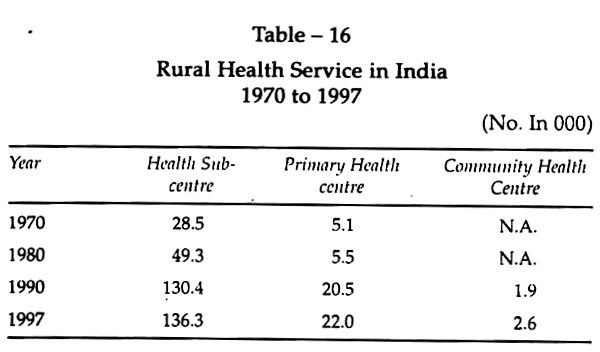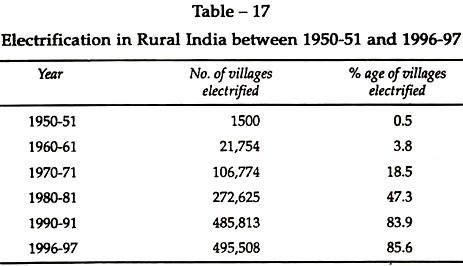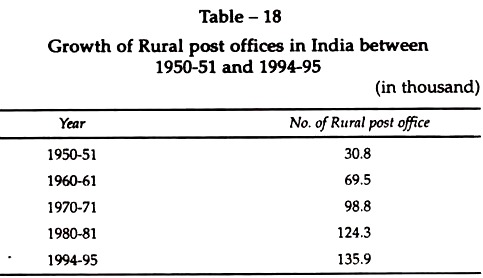Here is a compilation of essays on the ‘Growth of Rural Economic Sectors in India’ for class 9, 10, 11 and 12.
Essay Contents:
- Essay on the Growth of Agriculture
- Essay on the Growth of Rural Industries
- Essay on the Growth of Service Sector
1. Essay on the Growth of Agriculture:
The Rural economic sector is often termed as natural resource sector presumably because the agriculture and allied activities reflecting the productive system of nature are the primary and predominant occupation of rural people. This sector is primary because it supplies basic necessities of human life, provides basic inputs for industries and in addition to this, purveys goods of exports.
India as an agrarian state has been given top priority for the development of agriculture. Although greater emphasis has not been given during the British regime but totally neglected. In the process of planned economic development the planners and policy makers have given utmost priority for the development of the said sector.
It is believed that, the rise in agricultural production makes important contributions to general economic development and that within considerable limits at least, it is one of the preconditions which must be established before a take – off into self-sustained economic growth becomes possible.
It is to say that, the development in agriculture is an essential condition for the development of the rural economy as well as the national economy. The growth of agricultural sector can be examined from few important aspects like, land use pattern, distribution of operational holdings, growth in area of crops, Growth in yield of principal crops.
Land Utilization:
The total geographical area of India is about 3.29 million square kilometers or 329 million hectares from the angle of detailed information about the utilization pattern, the area is primarily divided into two categories, i.e. (i) non-reporting areas-the areas for which statistics is not available on accounts of physical and/or political reasons, (ii) reporting areas. The land utilization pattern in India since first plan i.e., 1950-51 to 1990 – 91 can be seen from the table 10.
The table 10 shows that the total geographical area of the country has remained at 328.8 or 329 million hectares over the period between 1950-51 and 1990- 91. The reporting area of the country was 284.3 million hectare in 1950-51. It is thus area for which no reporting was exists stood at 44.5 million rectors.
The total reporting area of the country has increased to 305 million hectares in 1990-91. Despite of various steps the un-reporting area has not declined significantly. This has declined to 23.8 million hectares or a decline of about 20.7 million hectares.
Over the period between 1950-51 and 1990-91. This is all the more significant in view of the fact that the areas which remained unreported are mostly back- ward and assume great importance in the improvement of the life of the people and ecology in the backward areas.
The area under forest has increased from 40.5 million hectares in 1950-51 to 68 million hectares in 1990 -91. This increase of about 27.5 million hectares indicated in improvement by about 67.9 per cent over 1950 – 51. The net increase in the area under forest is the ultimate outcome of the changes that have taken place in the reporting area, the replacement of forest by net sown area, pastures and non- agricultural uses and the afforestation programmes.
The net area sown was 118.7 million hectare in 1950-51. This has increased to 142.2 million hectares in 1990-91. The net sown area has increased by 23.5 million hectares which indicates a percentage change of 19.8 per cent over 1950-51. The cropping intensity of the land has also increased from 111.1 per cent in 1950-51 to 130.5 per cent in 1990-91.
The table further reveals that over the period between 1950-51 and 1990-91 an additional 53.6 million hectare land was brought under plough registering the net increment of 40.6 per cent. As for as the net area sown is concerned, the additional accretion was limited to 23.5 million hectares i.e., 19.8 per cent.
The constraints of topographical conditions of soils, inadequacy of farm inputs etc. on the one hand and the restraints effected by an unceasing process of urbanization on the other have been the factors which impeded the improvement in the cropping intensity.
However, despite, these banes, it improved if not substantially, but marginally. Besides, these problems, rural industries like potteries, bricks making, quarrying etc. are further curtailing the possibilities of enhancing the cropping intensity.
The net area irrigated was 20.9 million hectares in 1990 – 51. This has increased to 47.5 million hectares in 1990 -91. It is thus, the net area irrigated has increased to about 26.6 million hectares over the period between 1950 -51 and 1990 -91. The net increment of 127.3 per cent was registered over the period under observation.
Despite of the increase, only 35 per cent of the net sown area are irrigated in India. Needless to add that if higher production growth targets in agriculture are to be attained then increasing the use of available irrigation potential and extension of the facility over larger cropped land would have to be attended to with due urgency.
Fertilizer is a catalyst to the use of other improved techniques for cultivation and improving the agricultural production. The per hectare consumption of chemical fertilizer was only 0.6 kg per hectare in 1950-51. This has increased to about 95.3 kg per hectare in 1999-2000.
Despite of such substantial increase in the fertilizer consumption by Indian farmers, the country has to import about 25 per cent of the total fertilizer consumption Technological transformation in agriculture in future would depend upon our ability to create conditions for raising fertilizer consumption.
Rapid increase in indigenous production has enabled to reduce the constraints of dependence on imports of fertilizers. It is believed that the fertilizer consumption helps to raise the productivity of seeds, use of pesticides at the proper time ensures against loss of crops due to damage by pest. The consumption of pesticides by Indian agriculture shows that only 2.35 thousand tons of pesticides have used in 1950-51.
This has increased to 82.36 tons 1990-91. The consumption of pesticides has increased by about 35 times over the period under observation. Thus, the consumption of pesticides has grown rapidly over the years. Advice from agricultural extension staff in this sphere has played a useful role in the matter of detecting the pest and in application of right type and dosage of pesticides.
The trends in progress of farm Mechanization shows that the Indian farmers were utilized only 7 tractor in one lakh hectare of land in 1950-51. This has increased to 710 numbers in 1990-91. Over the period, the use of tractors has increased by about 100 times. The use of other modern farm machinery has also been increased over the period between 1950-51 and 1990-91.
Although there has been a noteworthy progress in farm mechanization which has been aided by credit facilities and subsidy particularly in electricity charges, the small size and scattered locations of small have deprived small and marginal farmers of the benefits of mechanization on the other hand most of the benefits of mechanization is largely availed by large and medium farmers.
The agricultural growth rate from the point of view of yield rate, the post-independence period can be conveniently classified into two periods such as, (i) Pre-green revolution period (1950-1965) and (ii) Post- green revolution period (1966- 1991). During the pre- green revolution period, rice recorded the most impressive growth rate in yield from 7 quintals per hectare in 1950 to 10.8 quintals per hectare in 1965.
The yield growth rate of wheat during the same period was modest as compared to rice. The yield per hectare in the case of wheat improved from 6.6 quintals in 1950 to 9.1 quintals in 1965. Among non-food grains cotton and sugarcane recorded modest growth rates.
During the second period, wheat and potato recorded the most spectacular growth rate. The per hectare yield of wheat has increased to about 24.9 quintals as compared to 19.3 quintals in case of rice.
In all other cases the yield growth rate was either modest or very poor. This shows that the new bio-chemical technology adopted after green revolution was particularly suited to wheat production but was not significant in the other crops.
The yield rates of commercial crops have been improving in most cases though in sugarcane the growth rate of productivity has more or less remained stagnant since 1970s. Notwithstanding the rapid growth rate of oilseed yields, shortages of edible oils are increasingly felt. In cotton we have attained overall self-sufficiency, though long-staple cotton for blended fabrics still presents some limitations.
The growth of agricultural productivity is the combined effort of the government and the farmers. The Government have prepared a number of schemes/programmes have been supported by plan outlay for agriculture sector. This can be seen from the following table.
The Table shows that the plan outlay for agricultural sector has increased from Rs 238 crores in First plan to Rs 13004 crores in Eighth plan. The share of this sector in the total plan out lay (for all sectors) has fluctuated. The sector received highest share of 12.9 per cent in fourth plan period and least of only 3.9 per cent in eighth plan period. The table given exhibits the fluctuations in the plan outlay for the sector.
2. Essay on the Growth of Rural Industries:
Rural Industrial sector is the second important economic sector after agriculture. The contribution of this sector to the rural economy as well as to the national economy is very significant.
The main advantage of small and rural industries is that they provide immense employment opportunities to the rural masses. This sector provides maximum support to agriculture by way of supplying its inputs and industrial services, encourage the growth of agricultural production by providing a widespread effective market opportunity.
The rural industries sector also aims to catering to towns and cities or even export markets and also earn foreign exchange for the economy. The rural industries sector implies a process through which a host of industries appropriate for rural areas are established to improve the socio-economic conditions of the rural poor.
No precise and formal definition of rural industries seems to be satisfactory but broadly it denotes a systematic programme to set-up large number of rural industries so expand the scope of employment of the rural people.
However, rural industries refer to a host of industries, which would not only include the traditional handicrafts and artisan industries but agro-based industries, light engineering industries, consumer goods producing industries etc. These industries may cater to the need of the locality i.e., rural people or out-side i.e. urban and foreign people. These industries may also be of small scale or medium scale organized in modern lines.
The important consideration here is that these industries are to be located in rural areas they are to utilize the available local resources natural and manpower and in the process contribute to the growth of employment and income of the rural people.
The rural industries sector consists of two broad sub-sectors such as modern small industries and traditional industries. The former covers small scale industries and the power looms whereas the later comprises of khadi, village industries, handlooms, sericulture, handicrafts and coir industry.
The economic history of India abounds in magnificent records of affluent village industries. They flourished through the length and breadth of the country not much on the support of the government but on the support of the people the dynamic entrepreneurship.
The commendable position of the village industries in the economy got eclipsed in the British rule. The British government had as a matter of policy, skilfully demolished the fabrics of the village industries. As a result, millions of village artisans were thrown out of jobs and reduced to the position of serfs at the mercy of village landlords. The onslaught had cut the very roots of industries and this made their rejuvenation difficult if not impossible.
Gandhiji, Who launched the Swadeshi Movement in early 20s counter-attack the prohibitive economic policies of the government and to infuse the momentum in the village communities for rebuilding of these industries afresh, had many a time reiterated that salvation of Indian villages and cottage industries.
This belief which was a bone of contention, is realistic and meaningful even in the present context of large-scale industrialization. However, this sector received utmost attention for development during different Five Year Plans.
The First Five Year Plan document has observed “A programme of village industries has to be supported by specific measures of assistance as well as by appropriate state policy. In addition to the emphasis on technical improvements, research and other measures for improving efficiency the primary objective of the policy should be to provide a field within which each cottage industry may be able to organize itself”.
Besides, the Article 43 of the Indian constitution, which refers to directive principles of state policy states “the state shall endeavor to promote cottage industries on an individual or co-operative basis in rural areas”.
In the light of the above principles the Government of India has been undertaking several measures from time to time on the basis of experience gained to meet new challenges confronting the industries. As against this background we would like to discuss the growth of rural industries during various Five year plans, since Independence.
The Government of India clearly announced in the First Five Year Plan that the development of village industries was as much a matter of state action as the increase in agricultural production. The first plan chalked out a programme of development of rural industries like village oil industry, soap making, palm gur industry leather industry, hand-made paper, bee-keeping, cottage match industry, Khadi and Coir.
The stress on these rural industries in the First Plan was a part of the programme of agro-industrial transformation of rural areas. As against this, the total plan outlay for the development was Rs. 42 crores. The second Five year plan aimed at developing small scale and cottage industries side by side with the large – scale industries.
The basic strategy of the second plan was to increase investment heavy industries to build up a strong capital base of the economy and to increase the supply of consumer goods by pushing up investment in the small and household industries.
A committee was set up under the chairmanship of Prof. D. G. Karve to examine the problems and prospect of village and small industries. The Karve Committee report was published in October 1955.
The Committee recommended one coordinated approach for the development of the rural industries. In order to provide institutional support to the village and cottage industries, six specialized boards were created during the plan period.
These are:
(i) All-India Handloom Board.
(ii) All-India Handicrafts Board.
(iii) The Khadi and Village Industries Board. (Later converted to Khadi and Village Industries Commission)
(iv) The Small Industries Development Board.
(v) The Silk Board, and
(vi) The Coir Board.
The Committee recommended for the organisation of industrial cooperative societies for the implementation of the rural industry programme. Under the State patronage and assistance many industrial centers cropped up. The important among them are, sports goods, glass ware, foot wear, leather goods, brass manufacture, handloom, bicycle parts, carpentry and wood works.
During the said plan Rs. 187 crores were allotted to village and small industries. Integration of village industries with the rural economy and formulation of the concept of rural industrialization were the two conceptual developments that had taken place during the third plan period.
A centrally sponsored scheme named Rural Industries Project (RIP) was introduced. The aim of the Rural Industries Project was to promote intensive development of village and small industries in selected rural areas. The actual expenditure during the Third Plan was estimated at Rs. 241 crores.
It was decided to protect small industries from the competition of large industries. However, the Government failed to reduce the competition among these. The fourth plan while admitting this fact cautioned the government in the following words.
The operation of the industrial licensing system has not been effective in preventing competition from the large industries and in providing the required degree of initial protection. Nor it has been possible to prevent concentration of industries in large cities and towns.
The Fourth plan placed an accent on the concept of viability as the basic requisite for undertaking any economic activity. The plan suggested for the adoption of intermediate technology on a wider scale as a suitable instrument to ensure the benefits of economic and social objectives.
The Ashok Mehta Committee, 1968 set out the concept of viability and provided a specific place for Khadi and village Industries in the industrialization of rural sectors. The estimated outlay in the public sector for the village and small industries worked out to be Rs. 251 crores in the Fourth Plan. Besides, the total amount of investment in the private sector exceeded the target of Rs. 560 crores envisaged in the said plan period.
The Fifth plan rightly mentions. A significantly large numbers of persons already dependent on traditional industries like handloom, agriculture, coir, Khadi and village industries are living below the poverty line.
Therefore, the important objectives of the programme for the development of different small industries in the Fifth Plan were to facilitate the removal of poverty and inequality in consumption standards of these persons through creation of large scale opportunities for fuller and additional productive employment and improvement of their skills so as to improve their level of earning.
The basic thrust of the Fifth Plan was on arresting the displacement of traditional artisans from the existing crafts providing fuller work opportunities, widening employment opportunities in backward areas and ensuring a level of earning adequate enough to meet the basic needs of life. However, the Government has launched several programmes for the development of these industries.
With this view, the revised Fifth Plan allocated a sum of Rs. 510 crores for village and small industries in the public sector. The important objectives of sixth Five year plan was to create employment opportunities as quickly as possible and arresting the massive migration from rural industries to swell the ranks of agricultural labour or to flood the slum population in the urban areas.
Besides, the primary objective for rural industrial sector would be to cover all the existing artisans by the development programmes of Khadi, village and Rural industries and to ensure continued and fuller employment to them in their present occupations.
In order to meet these objectives the Sixth plan allocated a sum of Rs 1,780 crores for village and small industries. However the actual estimated outlay worked out to be Rs 1952 crores for 1980-85. This sector have, received 1.8 per cent of the total outlay.
A review of the progress of the sixth plan reveals that production in this sector has increased from Rs 33,538 crores in 1979-80 to Rs 65,730 crores in 1984-85 and export from Rs 2,281 crores to Rs 4558 crores during the period under observation. With regard to employment, it increased from 234 lakh persons in 1979-80 to 315 lakh in 1984-85.
Whereas the output target was exceeded in money terms, the employment target could not be achieved, but there was a shortfall to the extent of 11 lakh persons. The power looms have exceeded the targets set for the terminal year of the sixth plan, the small industries have achieved the targets in terms of output, employment and exports. The performance of handicrafts was satisfactory.
The important objectives for village industries during Seventh plan (1985-90) period was:
(i) To assist in the growth as widespread dispersal of industries,
(ii) To increase the level of earnings of artisans,
(iii) To ensure regular supply of goods and services through use of local skills and resources
(iv) And to develop entrepreneurship in combination with improved methods of productions.
The said plan made a provision of Rs. 2,752 crores for village and small industries which is 1.5 per cent of total plan outlay However, the actual expenditure for 1985-90 ‘the period of the Seventh plan had been estimated at Rs 3,249 crores.
A review of the progress of village industries, handloom cloth and coir yarn and coir products fell short of their respective target. Exports from this sector have increased at a compound rate of 26.57 per cent. In the case of employment generation, the compound growth rate was only 4.43 per cent.
During two Annual plans i.e., 1990-91 and 1991-92. The growth rate achieved during the seventh plan is not maintained on account of constraints of foreign exchange affecting the availability of imported raw materials, components and capital goods, credit squeeze, high rates of interest, recession of foreign markets etc. In the new orientation to planning during the Eighth plan, people’s initiatives and participation were the key element in the process of development.
Greater emphasis was also laid on private initiative in industrial development. Several activities pertaining to this sector like processing of agricultural produce in rural areas, sericulture and allied activities have been identified as critical goals in priority sector. The programmes for selected villages for poverty alleviation through increase in employment.
It was also aimed to make free innumerable rules, regulations and bureaucratic controls. The total plan outlay of Rs 2799 crores was envisaged for Eighth plan period .The production of village and small industries during 1993-94 to 1996-97 can be seen from the Table 12.
The production in khadi, small-scale industries, Handlooms, Handicrafts sector increased significantly whereas the increase in the production of remaining activities is marginal. It is thus more emphasis is need to be given for the development of village industries, coir fiber, raw silk, power looms for the over-all development of rural industries in the country.
The generation of employment during 1993-94 and 1996-97 can be seen from the table given below:
The data available indicates that, there is a change in employment opportunity of about 7 per cent during the period between 1993-94 and 1996-97. The generation of employment in Khadi sector is negative i.e., (-) 3.4 per cent whereas employment opportunity is highest in power looms sector i.e., (+) 18.2 per cent over the period tinder observation.
It is thus the employment opportunity in Khadi and coir industry is declining for the entrepreneurs, although there is enough scope for the development of such industries. The Government is required to create appropriate conditions for the growth of the said rural industries in India, in order to extend employment opportunities to rural people in general and rural unemployed youths in particular.
3. Essay on the Growth of Service Sector:
The rural service sector comprises of rural roads, rural transportation, rural education, rural health, rural electrification rural communications and other rural service sectors.
(i) Rural Roads:
The importance of roads in general and rural roads in particular is rightly stated in the seventh plan (1985-90) document since the country’s economy is still largely agrarian in character and the settlement pattern is rural oriented, roads constitute a critical element of the transportation infrastructure.
The rural roads in India mostly constructed under various rural development programmes. Besides the village panchayat, the PWD etc. are also responsible for the expansion of rural road facilities in the country. As an important input for socioeconomic development of rural India the planners and policy maker have been laid emphasis on the development of roads in India during different plan periods.
The Third plan aimed at bringing every village in a well-developed agricultural area within 6 Kms of metalloid roads and 2.5 Kms of any road. The Minimum Needs programmme (MNP) during Fifth plan period had given top priority for the development of rural roads in India. The development of rural roads was also received importance in employment generating and Area development programmes implemented in India.
The linkage of village by all-weather roads as on March 1994 can be seen from the following table-14.:
It is observed from the table-14 that about 46.6 per cent of the total village have linked with all-weather roads in 1994. However, an estimated 90.2 per cent of the villages with population over 1500 and 72.1 per cent of the villages with population between 1000 and 1500 were linked to all -weather roads in 1994.
It is also noticed that only 36.5 per cent of the villages with population below 1000 were linked with all- weather roads. Its is thus about 63.5 per cent villages with population below 1000 still remain inaccessible by all-weather roads, as against 53.4 per cent villages for all category population.
The main problem of such a situation is that at present several organizations handle road construction and maintenance resulting in duplication of effort, lack of uniformity and imbalance development of the network.
There is, therefore need to unify the organizational structure for rural road planning, construction and maintenance so as to derive the maximum benefits from the programmes. The Prime ministers Rural Road Programme is the right step to attain the same.
The rural road Transport is of great importance both for movement of passengers and goods. It is ideally suited for short and medium distances because of its inherent advantages such as easy availability and flexibility of operation adaptability to individual needs door to door service reliability flexibility of operation adaptability to individual needs door to door service.
This system provides one of the basic infrastructure facilities for economic development of backward areas besides being the feeder service to rail traffic, ports and harbours, and urban areas.
The goods transport in rural areas is mostly controlled by bullock-carts, tractors, trucks, mini trucks and other small transport operators. Whereas the passenger services are provided both by public and private sector. The Passenger transport vehicles in rural areas consists of Buses, Trekkers, Auto- Rickshaws and other small transport operators.
(ii) Rural Education:
India’s ancient culture, civilization and history are a well- documented testimony to the great strength of education, which catapulted the Indian civilization to its zenith. . Education has always been considered as the only key component of human development, the only and greatest liberating force.
Hence, traditionally, education has always held the most venerable position in our society. Education was the instrument by which the British sought to maintain and strengthen their economic, political and military domination over India. The British adopted a unique model of educating an elite through a foreign language i.e. English.
After Independence, the Government of India has continued with the British Education Model as well as the practice. It is true that there is the provision of free and compulsory education for children up to the age of 14 years has not been achieved in our country. Since Independence a number of educational policies programmes, schemes has been adopted in India.
Besides, a number of commissions and committees have also been constituted in India for the spread of education and attainment of total literacy. It is believed that, India live in villages, the spread of education in rural areas received top priority by Planners and policy makers. The Educational Institutions imparting education at different levels and the enrolment of students therein can be seen from the table given.
The table reveals that the educational Institutions in rural areas and the enrolment of students therein are lagging behind the rural population, although it has increased since 1951. It is also observed that at-least 32 Million rural primary school age children do not attend school, even in states with high participation rates.
Poverty, lack of awareness and sincere appreciation among parents about the importance of children’s education, family compulsion to engage children for seasonal manual work on the farms are among the factors responsible for irregular attendance and dropouts. The planners and policy makers have been laid emphasis to wipe out such deep-seated problems.
In this connection National education policies introduced and special programmes schemes were also been implemented. The important schemes for education are, Non – formal Education 1979-80), Operation Blackboard (1986) District Institute of Education and Training (1988), Total literacy campaign (1988), Minimum level of learning (1989) and District Primary Education Programme (1992).
Despite of various steps the goal has not been achieved in our country. It is thus required to redefine the education and its infrastructural facilities as per present competitive global economy.
(iii) Rural Health Services:
Health of the people is not only a desirable goal but is also an essential investment in human resources. The Development and strengthening of rural health infrastructure through a three tier system of Health sub-centres, primary Health Centres and community Health centres for delivery of health and family welfare services to the rural community was continued during the plan periods. The growth of such centres can be seen from the table no 16.
The available data reveals that the rural health sub-centres have increased from 28.5 thousand in 1970 to 136.3 in 1997. The four-fold increase was registered over the period under observation.
The same situation was also experienced in case of primary health services. The total number of community health centres stood at 2.6 thousand in the year 1997. The total number of rural dispensaries and rural hospitals was 11.0 thousand and 4.3 thousand respectively in the year 1993.
Besides, there are 0.68 hospitals and about 19.4 beds per lakh of rural population in 1992. In order to support the rural health service centres there are 2.7 thousand specialists, 27 thousand doctors, 4.4 thousand ophthalmic assistants, 20 thousand pharmacists, 11 thousand laboratory and X-ray Technicians, 12.7 thousand nurses and mid wives, 34.7 thousand health assistants and 196 thousand Health workers in our country as on March 1996.
(iv) Rural Electrification:
Electricity is a vital input for industrial and agricultural development. Rural electrification as a plan programme was introduced in the First plan. It was initially envisaged to provide electricity as a social amenity to rural areas and was confined only to a few states.
The importance of this programme was especially recognised during the drought in the mid – sixties, when lift irrigation had to be resorted to on a large scale to save subsistence crops.
The rural electrification programme gained special importance for providing electricity for operating agricultural pump-sets to utilise available ground water potential. This programme was subsequently integrated with the minimum needs programme. The programme further strengthened by the formation of Rural Electrification Corporation (REC) in 1969.
The REC is playing an important role by providing over 90 per cent of the funds for rural electrification as concessional loans to the state electricity Boards or other relevant governmental organisations engaged in the spread of electrification in rural areas of the country.
The progress of electrification in Rural India since Independence can be seen from the following table:
It is observed from the above table that, at the time of independence, only 0.5 per cent of the villages in the country were electrified. This has increased to 18.5 per cent in 1970-71. Thereafter, the increase has been very fast covering about 85.6 per cent of villages with electricity in 1996-97.
The developed states like Andhra Pradesh, Gujarat, Haryana, Karnataka, Kerala, Maharashtra, Punjab and Tamil Nadu were achieved 100 per cent in connection with rural electrification. Whereas, this is around 50 per cent in some of the North-Eastern states like Meghalaya and Arunachal Pradesh.
(v) Rural Communication System:
Efficient and well developed communication system has become synonymous with modernity and economic growth. For developing countries like India, it is one of the critical inputs, which would determine the pace of socio-economic transformation of society. Telecommunication and posts are the two main constituents of any modern communication systems, this is also applicable in the rural areas.
The history of modern postal system in India may be traced back to 1837 when postal services and airmail services were opened in Pre-Independence periods. However remarkable progress has been made in post- independence periods. A number of policies were initiated for the development of postal services in rural areas.
Under the revised policy for opening of post offices in rural areas made effective from 28th August 1978, norms have been liberalized, for opening of post offices in backward hilly and tribal areas.
A post office can now be opened is a Gram panchayat village, if there is no other post office within three kilometers and non-Gram panchayat village with the minimum population of 1000 .The growth of rural post offices in India since independence can be seen from the table 18.
The above table reveals that, the number of rural post offices in India has increased from 30.8 thousand in 1950-51 to 135.9 thousand in and 1994-95. Thus, the growth of 4.4 times has registered during the said period. The rural population per post office was about 10 thousand in 1950-51 has reduced to about 5 thousand in 1994-95 Besides, post offices the rural telecom services has also received emphasis during the plan periods.
There are 17 thousands rural telephone exchanges with 1508 thousand telephone lines in India, according to 1995. In India there are 186 thousand villages having public telephone facility in the year 1995.
Despite of these efforts, the percentage of telephone connections in rural areas to total number was only 17.8 per cent as against the percentage of telephone exchanges in rural area i.e. 84.7 per cent in 1995. The villages provided with public telephone were only 32.3 per cent in the said year.
(vi) Rural Marketing:
Marketing facilities and services are the prime- movers in the wheel of economic growth of a country, for they provide channels for effective and efficient flows of goods and services from one sector to another. Their need is directly felt when centres of production are widely and remotely spread and also when volume of goods and services expand a pace.
The rural marketing system connotes marketing functions and facilities obtained in rural areas mainly for outflow of agricultural produce but also for inflow of other goods for consumption of rural people.
It is evident that the rural marketing in India mostly controlled by the middlemen like village trader, Itinerant trader, Kuchcha arhatiya and pukka arhatiya. Besides these, there are commissioning agents whole sales, retailers, cooperatives and the government.
The rural markets that have been in existence since time immemorial exemplifies the age old marketing traditions of our country. The rural marketing in the 19th and 20th century was plagued with myriad of malpractices in order to mitigate these; various market legislative measures were enacted from time to time. However, the commencement of the five year plans provided an opportunity for the states to take an active lead in regulating markets by way of legislation all over the country.
The market regulation has gone a long way in overcoming the malpractice and streamlining existing markets as well as new markets. State Governments are responsible for such enactment’s though the central government provides all technical assistance and facilities.
The main provisions of these enactment are:
(i) To regulate products (Agricultural) by making an official notifications.
(ii) To constitute market committee for the management of regulated markets.
(iii) To define the area of regulated market.
(iv) To provide standard market yard.
(v) To conduct/supervise the deals among the parties.
(vi) To provide for the use of standard metric weights and measures.
(vii) To provide amenities such as drinking water, water troughs for cattle, cattle sheds, rest houses, canteens etc.
There have been obvious benefits by the establishment of regulated markets in rural areas of the country. The growth of regulated markets can be seen from the table given below i.e.; table no 19.
It is revealed from the above table that the growth of regulated markets has been steady and impressive, this has increased from 286 in 1950 to 7062 in 1998. This registered about 25 time growth during the period under observation. Utter Pradesh, Bihar and Maharashtra are prominent states where the number of such markets has been larger than other states.
It is thus, the distribution of regulated markets across the country has been uneven and operational efficiency is debatable. Besides, this there is also a wide institutional approach to the rural marketing. Important among them is the cooperative marketing system comprises of primary marketing societies, District Marketing societies, Apex marketing societies and National agricultural marketing federation.
Apart from Legislative as well as Institutional approach there are a number of agencies sponsored by the Government for the development of marketing functions relating to agricultural and rural produces prominent among them are Central Warehousing Corporation of India, National Cooperative Development Corporation, Directorate of Agricultural Marketing and Food Corporation of India.
